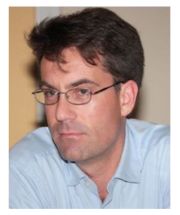Giovanni Costantini
Professor of Physical Chemistry
 My research aims are focused on the development of novel and efficient approaches for combining molecular building blocks into desired functional architectures and on the exploration of their fundamental interactions and properties.
My research aims are focused on the development of novel and efficient approaches for combining molecular building blocks into desired functional architectures and on the exploration of their fundamental interactions and properties.
g dot costantini at warwick dot ac dot uk
02476 5 24934
Office A1.02
Website
Biography
- 2016 Professor in Physical Chemistry, University of Warwick (UK)
- 2010 Associate Professor in Physical Chemistry, University of Warwick
- 2008 Assistant Professor in Physical Chemistry, University of Warwick
- 2002 Group Leader, Max-Planck-Institute for Solid State Research, Stuttgart (Germany)
- 2000 Postdoctoral Fellow, Max-Planck-Institute for Solid State Research, Stuttgart (Germany)
- 2000 PhD, Università di Genova (Italy)
7
Nanotechnology is essentially based on the ability to easily mass fabricate nanoscale structures reaching down to the atomic scale. At this level, conventional top-down approaches become unusable. The natural alternative is self-organized growth, where nanoscale arrangements are built from their atomic and molecular constituents by processes intrinsically providing structural organization. Supramolecular self-assembly is a very attractive chemical strategy to achieve this goal both for its efficiency and for the high structural quality that can be obtained.
Our research objectives are focused on the development of novel and efficient approaches for combining molecular building blocks into desired functional architectures and on the exploration of their fundamental interactions and properties.
Many of the devised applications of these new nanomaterials involve the presence of a substrate for their accessibility and their connection with the macroscopic world. As a consequence, most of our research is concentrated on building and characterising functional supramolecular architectures at surfaces. To this aim we employ a range of deposition methods and state of the art characterisation techniques including scanning probe microscopy and electronic spectroscopy.
Current teaching:
- Electrons in Solids and Materials (CH274), Year 2
- Surfaces and Interfacial Chemistry (CH3F1), Year 3
- Advanced Physical Chemistry and Laboratory (CH3F1), Year 3
- Frontier Techniques in Analytical Science (CH921), Postgraduate
- Microscopy and Imaging (CH922), Postgraduate
I am supervising the following PhD students:
- Joseph Parker, Molecular-scale structural properties of conjugated polymers for biosensors
- Mona Braim (with Phil Woodruff, Warwick Physics), Quantitative structural determination of metal-organic interfaces
- Stefania Moro, Local electronic properties of adsorbed functional macromolecules
- Alex Luci, Conjugated polymer imaging
- Marco Turano, Molecular-scale understanding of corrosion inhibitors
- Harry Pinfold, Supramolecular self-assembly at surfaces
- Jonathan Blohm, Reactions and self-assembly of short peptides on metal surfaces
I always welcome applications from those interested in pursuing either a PhD or Postdoc position in the group.
M. Xiao, B. Kang, S.B. Lee, L.M.A. Perdigão, A. Luci, S.P. Senanayak, M. Nikolka, M. Statz, Y. Wu, A. Sadhanala, S. Schott, R. Carey, Q. Wang, M. Lee, C. Kim, A. Onwubiko, C. Jellett, H. Liao, W. Yue, K. Cho, G. Costantini, I. McCulloch, and H. Sirringhaus
accepted in Adv. Mater. (2020)
J. Lawrence, G.C. Sosso, L. Đorđević, H. Pinfold, D. Bonifazi, and G. Costantini
Nat. Commun. 11, 2103 (2020)
selected for Nature Communications Editors' Highlights
H. Pinfold, C. Greenland, G. Pattison, and G. Costantini
Chem. Commun. 56, 125 (2020)
H. Chen, A. Wadsworth, C. Ma, A. Nanni, W. Zhang, M. Nikolka, A.M.T. Luci, L.M.A. Perdigão, K.J. Thorley, C. Cendra, B. Larson, G. Rumbles, T.D. Anthopoulos, A. Salleo, G. Costantini, H. Sirringhaus, and I. McCulloch
J. Am. Chem. Soc. 141, 18806 (2019)
P.J. Blowey, S. Velari, L.A. Rochford, D.A. Duncan, D.A. Warr, T.-L. Lee, A. De Vita, G. Costantini, and D.P. Woodruff
Nanoscale 10, 14984 (2018)
D.A. Warr, L.M.A. Perdigão, H. Pinfold, J. Blohm, D. Stringer, A. Leventis, H. Bronstein, A. Troisi, G. Costantini
Sci. Adv. 4, eaas9543 (2018)
A. Della Pia, M. Riello, A. Floris, D. Stassen, T.S. Jones, D. Bonifazi, A. De Vita, and G. Costantini
ACS Nano 8, 12356 (2014)
S. Kervyn, N. Kalashnyk, M. Riello, B. Moreton, J. Tasseroul, J. Wouters, T.S. Jones, A. De Vita, G. Costantini and D. Bonifazi
Angew. Chem. Int. Ed. 52, 7410 (2013)
